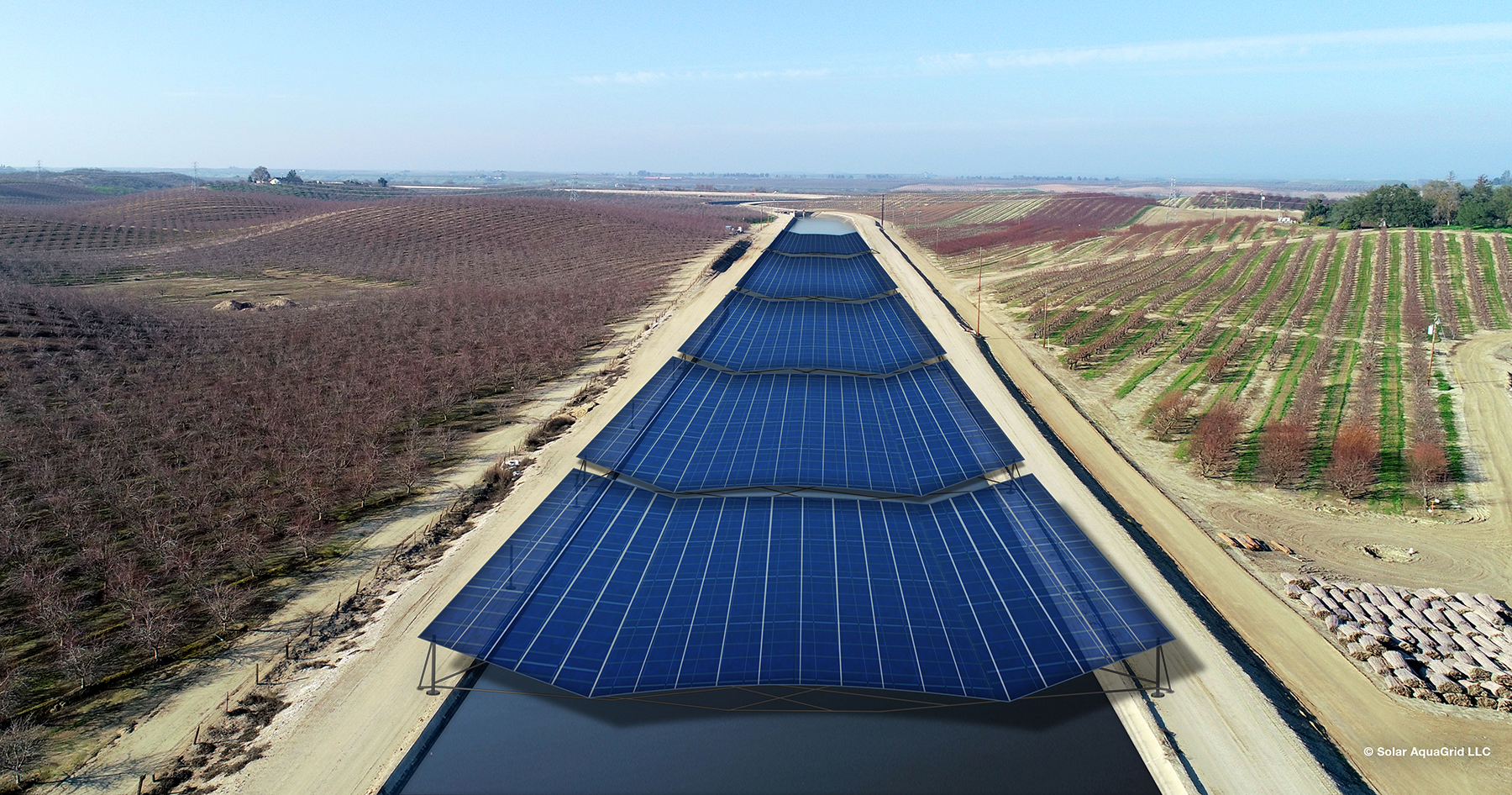By Leslie Nemo
This fall, a research, industry, and government coalition will break ground on Project Nexus, a pilot project to install open-sided solar panel canopies over select sections of California canals. The two main goals, collaborators say, are to generate renewable power and conserve water while squeezing a little extra value out of land already used as infrastructure.
The project, which has $20 million in funding thanks to a line item in the 2021-22 California budget, traces its origin to a study that investigated what benefits might come from covering the state’s canals with solar panels. The study, “Energy and water co-benefits from covering canals with solar panels,” was published last year in Nature Sustainability.
“This kind of project is going to allow us to test our hypotheses in the real world, and that's super exciting,” says Brandi McKuin, Ph.D., a study co-author and current postdoctoral researcher in environmental engineering at the University of California, Santa Cruz. Her research on the paper was conducted when she was earning her doctorate at the University of California, Merced.
The scale of the installation is small: Panels will cover just under 2 of the 3,945 mi of canals that extend through the state and were included in the researchers’ analysis. Despite the size, every partner involved will be watching to see how — and if — benefits of the combined solar-canal system materialize.

Solar arrays already top some canals in Gujarat, India. And French agencies recently announced plans to expand similar infrastructure after a pilot facility went up in 2016. But two companies, Solar AquaGrid LLC and Citizen Group, wanted to see how solar-shaded canals would pan out in California.
Solar AquaGrid, a self-described “project development and envisioneering studio,” was co-founded in 2015 by Robin Raj and Jordan Harris, the latter a founder of Virgin Records’ American division in 1986. Citizen Group, a marketing and public relations agency, was founded by Raj in 2007. The organizations proposed to the researchers that they study the use of solar panels suspended over canals in the state and sourced the project’s funds, some of which came from power generation company NRG Energy.
If all of California’s canals and aqueducts were shaded with solar, the installations could provide 13 GW of solar energy capacity, according to the authors’ calculations. The shade provided by the panels could reduce water evaporation, too, and save an estimated 63 billion gal. of water annually, enough to meet the at-home water needs for more than 2 million of California’s nearly 40 million residents. Pairing the infrastructure could also boost solar array performance, reduce canal weed growth, and improve water quality, the authors suggested.
Attracting a host
All the proposed benefits to installing solar over canals appealed to the Turlock Irrigation District, which is in California’s Central Valley. But the potential to generate electricity was the most attractive element, says Josh Weimer, the external affairs department manager for TID. This is because the irrigation district is one of four in the state that also provides wholesale and retail power.
By 2030, 60% of retail power sales in California need to come from renewable sources and 100% need to be carbon-free by 2045, according to state law. TID currently owns and sells energy from natural gas, hydropower, solar, wind geothermal plants, and more. The pilot project won’t meaningfully change TID’s current sustainability investments — the installed panels should produce 5 MW of power, or 0.6% of the district’s renewable profile as of 2015. Still, “that’s 5 MW we don’t have to buy elsewhere,” Weimer says.
A lot of the district’s water infrastructure is in environments that are fairly typical for the state, says McKuin, making them good baseline sites for estimating how solar over canals elsewhere in California might function. Also, “I think what set TID apart from others initially was (that) our immediate response wasn't no,” Weimer says.
TID, Solar AquaGrid, and the California Department of Water Resources pursued funding for a test facility based on the conditions the Nature Sustainability paper laid out.
The pilot sites
Only a few details of what the constructed projects will look like have been finalized. The irrigation district selected two main sites — a section covering a 25 ft wide canal and a nearby regulating reservoir as well as a stretch of a 110 ft wide canal. (The DWR is particularly interested in the performance of the 110 ft wide canal, as its aqueducts are fairly wide.)
These sites already have nearby feeders with the capacity to carry more generated power to substations, so TID doesn’t have to upgrade any electrical infrastructure to incorporate the new solar energy. The power generated by the panels will funnel directly into the grid or into accompanying battery storage. Because the reservoir needs power to pump water in and out, the district wants to align the solar installation and battery storage with that electricity demand, Weimer says.
The structure that will arch over the canals is mostly still undetermined too. While the study concluded that a suspension cable installation was more cost-efficient compared with steel truss supports, the project will still test two different solar support systems. Logistics and costs of installation will vary, depending on canal size.
The support structures will likely hold a few types of solar technologies, but which ones will be used has not been decided yet.
Ancillary benefits
Once the solar structures are standing, the project will track how the ancillary benefits play out. The irrigation district is eager to see how the shade from the solar panels will prevent the growth of aquatic weeds, a frequent foe that can clog water delivery gates.
The shade created by the solar panels could also potentially limit algae growth in the water, reducing the threat the microorganism poses to water quality, a detail the DWR finds relevant for canals responsible for potable water.
The benefits of combining the infrastructure elements extend in both directions too: The lower temperatures and wind protection provided by the solar panels could reduce water evaporation within the canals, and the cooler conditions underneath the solar panels created by the water within the canals could possibly boost solar cell performance.
The final cost-benefit analysis of the project particularly intrigues McKuin. In her and her colleagues’ analysis, McKuin found the construction costs of building solar over the water infrastructure were higher than those of building comparable solar facilities on land.
However, what made it economically worthwhile to build solar over canals was the financial benefits of those ancillary benefits. If the pilot project proves successful, replicas of Project Nexus might appeal to other regions interested in community-choice solar, McKuin thinks.
Land use considerations
For an entity like Turlock, expanding its infrastructure footprint beyond the canals that have been in place for over a century would be expensive. The canals irrigate valuable farmland and TID already locates as much of its electric infrastructure as possible along the sides of the canals themselves to avoid needing further land easements. “If we wanted utility-scale solar in our service area, we’d have to buy some highly productive ag land, which drives up the whole cost,” Weimer says. Project Nexus offers a different choice. “If this is successful on less than 2 mi of canals, we have 250 more that we might be able to put solar on.”
McKuin suspects that energy generation of solar panels extended over canals might not compete with large-scale installations like those that are popping up in the state’s Mojave Desert. But she points out that California has to square energy goals with its 30x30 program, which aims to preserve 30% of the state’s land and coastal water by 2030. “If we keep building huge-scale utilities out in the desert, it’s at the expense of biodiversity,” McKuin says.
Similar concerns rattle construction projects elsewhere in the nation. The results from a program like Project Nexus could show how already disturbed land might serve a second purpose to generate clean power, an option environmental advocates have long pushed for.
Ellen Bruno, Ph.D., an economist in the Department of Agricultural and Resource Economics at the University of California, Berkeley, says she’d guess that the cost of building solar over California’s canals would add up to be larger than the gains of reduced evaporation. “At some point, the costs associated with conserving an additional drop of water exceed the benefits,” she says. But, she notes, if solar expansion is inevitable, then maybe hanging the panels over canals could tack on some extra benefits that might not come from building elsewhere.
Project Nexus has through 2026 to spend its state-allocated money, which Weimer thinks it will do with ease. During and after construction, researchers affiliated with the original study will be there to collect information — data other irrigation groups are eager to get their hands on. Already, dozens have reached out to Weimer from around the U.S. and abroad asking for more details.
“Some (irrigation groups) are surprised that we took on the challenge,” Weimer says, “but then mostly others are very interested in being kept up to speed.”



